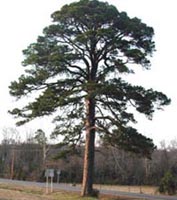Resource Library
Plant of the Week: Yellow Pine (Shortleaf Pine)
The University of Arkansas System Division of Agriculture does not promote, support or recommend plants featured in "Plant of the Week." Please consult your local Extension office for plants suitable for your region.
Plant of the Week
Shortleaf Pine, Yellow Pine
Latin: Pinus echinata

Drive through the woodlands of the Ouachita Mountains and you see plenty of pines. But these trees are newcomers, mere saplings replacing the forest giants that once occupied this same ground. The old growth forest was made up of Pinus echinata, known to foresters as shortleaf pine. Sawmill operators call them yellow pine.
The shortleaf pine is a big tree with an extensive native range in the southeastern states, ranging as far north as the Ohio River valley and as far west as the Great Plains. It tolerates a wide array of soil types and occurs mixed with hardwoods or in pure stands, often quickly invading old fields and roadside cuts.
In Arkansas, shortleaf pines are relatively unimportant as a timber species in the modern forest industry. Allan Murray, the director at the Arkansas Forestry Commission’s Baucum Nursery near Little Rock, says that his nursery grows about a half million shortleaf seedlings per year, compared to about 130 million of the faster growing loblolly pine seedlings produced each year in the state. About the only reason Murray sees for planting shortleaf pines is that they are better at self-regeneration in drier, upland sites than loblolly pine.
Old shortleaf pines can reach 100 feet in height with the lower two thirds of the trunk devoid of branches, making them good feedstock for the sawmill. Solitary trees retain lower limbs and are quite picturesque in silhouette. Older trees develop a distinctive, patch-like, orange-red scaly bark that easily separates them from the loblolly pine with its gray furrowed bark.
The flexible, bluish-green shortleaf pine needles are three to four inches long and produced in bundles of two or three. Young trees are fast growing and assume a pyramidal habit in their youth, eventually losing lower limbs and developing the distinctive sculptural crown seen in old trees.
Forest management is a relatively new science in America. With our vast, seemingly inexhaustible timber resources early industry moguls practiced the "cut out and get out" brand of forestry we strongly denounce in today’s developing nations. Forestry practices began to change about 1900 when the last white pines were harvested from the Great Lakes region and foresters began to look about for new areas to conquer. The virgin shortleaf pine forests of Arkansas beckoned.
Teddy Roosevelt acted on the recommendation of Gifford Pinchot - the first director of the newly established U.S. Forest Service - and established the Arkansas National Forest in 1907 (renamed the Ouachita National Forest in 1926) from unclaimed publicly owned land in the Ouachita Mountains of Arkansas and Oklahoma.
During this same period developers began to assemble parcels of land for logging operations in the region. By buying land from discouraged farmers, timber harvesting rights from heirs or timber harvesting tracts from the new National Forest, large sawmill operators such as T. W. Rosborough and the Dierks family began to reshape the landscape of the Ouachitas. The story of this harvest, which was complete shortly after the end of WW II, is told in Ken Smith’s 1986 book, Sawmill.
By: Gerald Klingaman, retired
Extension Horticulturist - Ornamentals
Extension News - March 21, 2003
The University of Arkansas System Division of Agriculture does not maintain lists of retail outlets where these plants can be purchased. Please check your local nursery or other retail outlets to ask about the availability of these plants for your growing area.